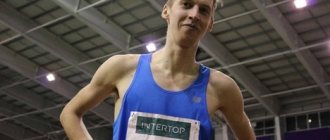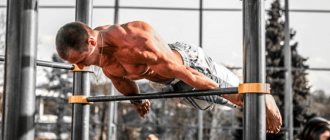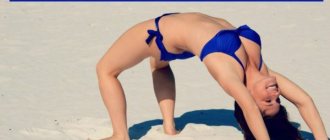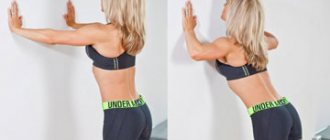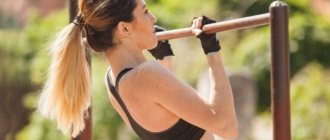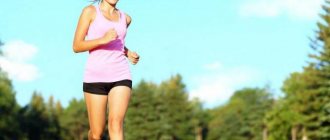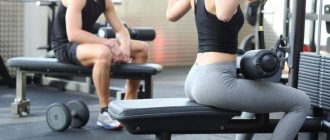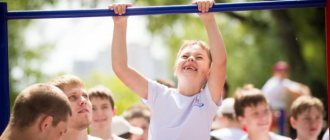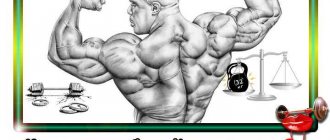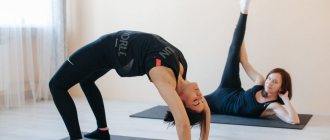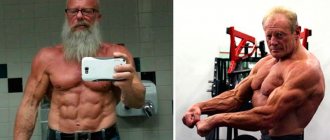Most gym goers are faced with a lot of questions. Their progress depends on the correct answers to these questions. There is a lot of misinformation on the Internet, especially about exercise in the gym. Bodybuilding for beginner athletes seems mysterious and difficult. The information from the article will help you properly organize training and recovery. Progress after reading is inevitable.
What exercises should a beginner do?
Only heavy basic exercises will turn a beginner weighing 65 kilograms into a huge athlete, whose weight fluctuates around the coveted hundredweight. Even if the goal is not to become that big, you will still have to make a base. Although there are exceptions everywhere.
The best exercises for an athlete who is just starting out are:
- Bodyweight exercises
(pull-ups and dips). - Squats and deadlifts
(after a month of training and strengthening the lumbar spine). - Extensions, hyperextensions and crunches on the abdominal muscles
(it is necessary to perform exercises to strengthen the core and prepare the body for heavy deadlifts and squats). - Classic bench press
(will strengthen and pump up the shoulder girdle). - Swing dumbbells into stolons from different positions, “reverse butterfly” simulator
(for uniform pumping of all bundles of deltoid muscles). - Leg press, lunges with dumbbells, hack squats
(an alternative to the classic squat for the first month of training). - Seated dumbbell press with emphasis on a bench
(the best basic exercise for the shoulders). - Upper side row
(great for athletes who don’t know how to do pull-ups). - Biceps curls, hammers
(exercises for building arm mass). - Bent-over dumbbell row with one arm, resting on a bench.
Exercises in simulators are also important and useful, but nothing can replace a barbell and dumbbells. They will be present in the training program for beginners, but only for variety, warming up the muscles, ligaments and joints.
Attenuated negatives
Once you've mastered the concentric exercises, add loose-negative movements that involve using straps to facilitate the eccentric phase of the bar movement—primarily the bench press and squat.
For loose negatives, tie one part of the strap to the top of the squat rack and wrap the other around the bar. As the bar descends, the strap will stretch, which will reduce the load during the eccentric phase and help initiate the concentric phase of the movement.
This strategy is designed to help the athlete move from concentric exercises to full range of motion. Isometric exercises teach you to take and maintain the correct position, concentric presses teach you to develop maximum effort from the starting position, and weakened negatives teach you to overcome all phases of the movement cleanly.
Useless exercises for a beginner athlete
In order not to get injured at the beginning of your journey, you need to know which exercises to perform with caution, and it is better to avoid them altogether. Such movements include:
- Weightlifting exercises: snatches, cleans and jerks.
Great for strength or endurance training, but not for building muscle. In addition, they are very traumatic and require perfect execution technique. - Concentrated biceps curls and half the other isolation exercises.
There's no point in them. - All exercises for calves and traps with free weights on the shoulders or in the hands.
Firstly, there is no benefit from such movements; if your calves are genetically weak, then no amount of calf raises will help. Secondly, the load on the spine during such movements is enormous and unjustified. - Forearm exercises.
Big forearms have nothing to do with a beautiful body. Only armwrestlers and armlifters need to develop these muscles. - The standing barbell press
is a great exercise for developing the shoulder girdle, but not for beginners. The peculiar technique, which requires good flexibility of the shoulder and wrist joints, will not allow a novice athlete to quickly master the movement. In addition to the difficult technique, it is worth mentioning the excessive load on the spine. - Bent-over barbell row.
You perform the movement in a tilted position, so the load on the lumbar spine is prohibitive. Let's leave the exercise to professionals and semi-professionals.
The remaining exercises, if performed correctly, only bring benefits and accelerate progress.
Periodization of loads and dependence on the cycle
The main mistake of trainers and women themselves is not to adjust the program depending on the phase of the menstrual cycle. The fact is that in women, progress slows down significantly in the second phase of the cycle. The process of gaining muscle mass after ovulation slows down, but overall endurance increases. These features of the female body must be used in strength training to achieve better results.
- During the follicular phase, or before ovulation, the body responds well to heavy loads. Moreover, during this period, glycogen is stored very quickly, so you can exercise longer and more efficiently.
- On the days of ovulation, the amount of estrogen increases sharply, and the amount of testosterone decreases. It is not possible to exercise intensively, as fatigue sets in quickly.
- After ovulation and before the start of the next cycle, it is recommended to focus on doing cardio, as the fat burning process accelerates during this period.
- Directly during menstruation, it is recommended to either take a break or exercise according to a simplified program, loading mainly the upper body, without working the abs and buttocks. During this period, you can limit yourself to isolated exercises.
Taking these nuances into account, every woman can achieve good results with regular training. Nutrition should be adjusted depending on what the girl’s goal is - to lose weight or increase body weight. In any case, you need to eat properly and balanced.
Technology is an important component of progress
Without proper technique in basic exercises, you won’t see big and beautiful muscles.
The first three months you need to train according to the Full body program.
(you can read the training program at the end of the article) to prepare the body for a long time of work on itself and establish the correct execution technique.
It would be ideal to work with a trainer for the first three months. If this is not possible, no problem. Do not hesitate to approach the instructor on duty and ask to show you how to perform the exercise correctly. If he is clueless (this often happens), ask for help from experienced comrades. There are many videos on the Internet with the correct technique, watch them before training, or before performing the movement and try to repeat.
When determining the correct technique for performing the exercise, you need to use light weight so as not to get injured. Record the exercise on your phone camera, then view and analyze what is missing to perform the movement correctly.
Stretching is the basis for proper exercise. Without stretching, you won’t be able to develop good technique in squats and deadlifts. Give it at least 15 minutes every day, preferably half an hour. The main thing is not to strain your muscles and ligaments intensely before training - this is a quick path to injury. Pay special attention to the flexibility of the spine, hamstrings and shoulder joints.
Read also: Muscle recovery after training
Medium rep sets
Tall athletes have long lever arms that interfere with proprioception and motor control. Overly intense training with high weights and low reps is tantamount to a dangerous, painful and potentially traumatic approach. Focus on extreme weights and one-rep sets, and your performance will decline much faster than with athletes with a normal lever length. Quality reps and a long athletic career are built on medium rep sets.
Adopt this strategy and do sets of 5-8 repetitions. If you want to gain muscle, increase your volume by increasing the number of sets per training session or training cycle. To increase strength, focus carefully on the starting position and perform high-quality repetitions that develop fierce tension.
How many times a week should you exercise
For the first three months, according to the Full body system, you need to exercise 2-3 times a week so that the muscles and ligaments have time to recover before the next workout.
After finishing classes on the Full body system, create a new training program. The split can even consist of 6 workouts per week. The main thing is that they are competent, and the body has time to recover.
If you can't decide on the number of workouts, then choose a standard three-day training split. After a year of training, experiment and find the best option.
Best time of day to exercise
The training should be carried out during the maximum performance of the body. For most people, this window is from three in the afternoon to six in the evening. There are exceptions!
If you like to train in the morning, train! Nothing wrong with that. The main thing is that your body feels good during and after exercise.
Modern realities of life dictate their own rules. Many people have to train late in the morning or at night. To bring yourself to your senses, it is recommended to take a shower, sometimes you can use a pre-workout complex, but you should not overuse it, otherwise you will get used to it.
Duration of training
Rumor has it that a workout should not last more than 45 minutes. That's bullshit! People are different, some people need to rest for 3 minutes between sets, but for others one will be enough. How to perform 6 exercises if the rest between sets is 3 minutes? No way.
It is important to monitor not the duration of the workout, but the time the muscles are under load. It is heavy loads that lead to poor recovery and overtraining, not long training.
By training intensively, you can load your muscles in 30 minutes. And if you train slowly, measuredly, then 90 minutes will not be enough. These figures do not include warm-up, cool-down and stretching.
Exercise as you feel and enjoy it, but remember that long rest (more than 5 minutes) negatively affects muscle growth . The main thing is not to chat, but to work!
How to select the weight of the projectile
There is no single recipe for selecting weights. The weights of the shells do not increase quickly. Throwing weights on the barbell every workout won’t work. If in the last leg workout you performed squats with a weight of 100 kilograms for 12 repetitions, then this time you can try squatting 102.5 kilograms for 12 repetitions. It is unlikely that you will be able to complete the planned 12 repetitions; you will end up with 10-11.
If the exercise is new to you, then you need to start with light weight. From approach to approach, the weight of the projectile must be increased based on sensations. This makes it easier to position the equipment and determine the working weight.
We leave only the concentric phase
Guys who constantly hit the doorway with their head experience certain difficulties with proprioceptive sensitivity and motor innervation. It’s as if the signal from the muscles to the brain and back takes a little longer than usual. As a result, the eccentric, or negative, phase of movement, or more precisely, its outcome, becomes a matter of chance: either the fixation of the body is lost, or the arms are crooked. In a word, the whole exercise is down the drain.
By focusing on the concentric phase (contraction phase), such as bench pressing in a squat rack or squatting in the same manner, lanky athletes will get some relief because the basis of these exercises will be isometric movements. They will allow you to improve your range of motion, stabilize your starting position, and perform the exercise with enough vigor and energy to develop strength and volume. And you won’t have to worry about a forced reduction in working weight.
The success of a concentric exercise depends on acceleration. Even with a lot of weight, you need to focus on moving the projectile from start to finish as quickly as possible. Stick to 3-8 reps for concentric exercises. If you do fewer repetitions, you turn the exercise into a quasi-maximum, unproductive movement.
Nutrition Basics for Beginning Athletes
Without proper nutrition, it is impossible to achieve impressive results.
To progress at the initial stage of training, it is enough to adhere to the following rules:
- Fractional meals.
At the initial stage, five meals are enough (excluding sports nutrition). - Sports nutrition is not necessary, but you can use it.
The main thing is not to get hung up and understand that these are additives to the main diet and nothing more. - Sweets, flour, fatty foods, fast food and other unhealthy foods will have to be excluded from the diet.
- Most carbohydrates should be consumed before two o'clock in the afternoon. After 5 hours, only protein and fiber.
- Increase your caloric intake by 15-20%.
Training takes a lot of strength and energy, so when you start training you need to eat more. - Forget about snacking, eat strictly according to plan.
- An hour before training you need to refuel well, whey protein is perfect.
- Within 45 minutes after training, you need to eat easily digestible food, such as bananas or mass gainer.
- Human tissue is 80% water. Consume about 3 liters of clean drinking water.
- Eat more fruits and vegetables to provide your body with all the nutrients it needs.
- Vitamin C, vitamin B6 and B12, fish oil are supplements that should definitely be present in your diet.
If money allows, then buy a vitamin complex so you don’t have to eat a bunch of pills. - Before going to bed, eat cottage cheese or drink casein protein.
Read also: Sports nutrition: how to take it?
The main thing to remember is that without the right food, training is useless, and you won’t be able to build the body of your dreams.
How long will it take to see the results of training?
It is impossible to answer this question specifically. Metabolic rate, natural testosterone levels, food digestibility, health, physique, predisposition to bodybuilding - these are just some of the factors that influence progress.
Let's take an average guy, with average health and capabilities. After about six months, his friends and family will begin to say that he has become broader in his shoulders, bigger in his arms, and generally matured. Of course, you can’t become an athlete in six months, but you can become slim and fit.
After 2-3 years of training, any gym visitor, with proper training and nutrition, will look like an athlete. Six-pack abs, 40-centimeter arms, relatively large legs and a generally toned body are guaranteed after a couple of years of working in the gym. Pointing fingers and saying “how huge!” They won’t, but no one will definitely call you a jerk.
Types of bodybuilding
Currently, the term "bodybuilding" is erroneously used to describe various disciplines. The most popular of them:
- Body-building. The distinctive features of modern bodybuilding are:
- Maximum development of muscle performance.
- Widespread doping. The form that we see at competitions like Mr. Olympia 2017 is unattainable without the use of pharmacology.
- Maximize muscle mass through nutrition and sports supplements.
- Neglect of the natural proportions of the human body.
- Low popularity. Bodybuilding in the form in which this sport exists now is practiced by no more than 5% of gym visitors.
- Classic bodybuilding. The distinctive features of classical bodybuilding are:
- The desire for maximum muscle hypertrophy without compromising proportions.
- The use of doping, but in moderation compared to the trends of modern bodybuilding. At the amateur level, doping is not widely used.
- Various variations like “Mens Physic” or other variations of “beautiful bodybuilding”.
- Relatively high popularity. About 15% of gym visitors engage in classical bodybuilding in various variations.
- Powerlifting. The distinctive features of powerlifting are:
- Development of maximum muscle strength at the expense of endurance and performance.
- Work in a limited number of exercises.
- Use of doping by professionals.
- Low popularity. About 5% of gym visitors engage in powerlifting.
- Crossfit. The distinctive features of CrossFit are:
- Maximum development of endurance at the expense of strength and performance.
- Building a “functional body” – a small amount of muscle mass, a minimal amount of subcutaneous fat.
- Using a circular training system, which is not used in bodybuilding.
- Low popularity in Russia and throughout the post-Soviet space. About 5% of gym goers do CrossFit.
- Fitness. Distinctive features of fitness:
- The main result of an athlete is an attractive body without excessive muscle mass and good health.
- Health comes to the fore. One of the main goals of fitness is to improve the health of the body and prevent the development of diseases associated with a sedentary lifestyle.
- Training with various equipment. Maximum variety of exercises.
- Healthy eating without the “bulk” and “cut” cycles.
- High popularity. About 30% of gym visitors are involved in fitness.
- Physical training. The distinctive features of physical education are:
- No load progression. In all of the above disciplines, the athlete gradually increases the load to adapt to training stress. Physical education is constant work with the same load.
- Striving for maximum health improvement. Health is the main goal of the “athlete”.
- Unknowing use. Some gym goers believe that they are doing fitness or bodybuilding, although in reality their training is related to physical education.
- High popularity. About 40% of gym visitors engage in physical education (intentionally and unknowingly).
Today we will tell you about what bodybuilding is for amateurs and professionals.
What results can be realistically achieved without the use of prohibited drugs?
A question that concerns most people who come to the gym for the first time. If the goal is to become a competing athlete in heavy weight categories, then you can’t do without drugs, but we are talking about training for health and a beautiful figure, so the body’s testosterone is quite enough.
Any gym goer can weigh 80 kilograms and have 6-pack abs. The cherished 100 kilograms of lean muscle is not an easy goal, but doable! You will have to spend many years to achieve it, but it is worth it.
